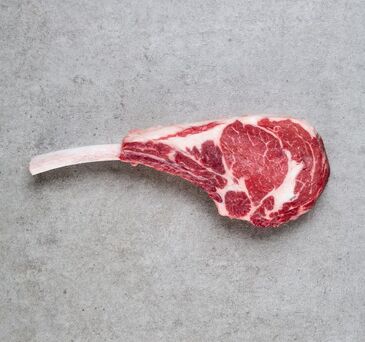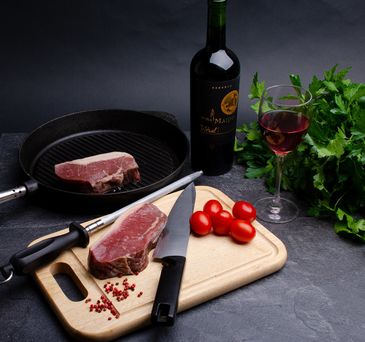How to Cook the Perfect Ribeye Steak
The ribeye steak is one of the most popular steaks in the UK for good reason. In steak terms, the ribeye has more tenderness than the rump and more flavour than the fillet. This cut comes from the rib portion of the cow and is typically the best part of this centre portion, or the ‘eye’’, of the whole rib steak. It comes from an area that does little work which in turn makes the ribeye steaks very tender. Additionally, they are very flavoursome because of that recognisable marbling of fat that runs through the meat. They typically come in 8oz or 10oz and when cooked right, are one of the most delightful steaks going.
Across the plains of the internet, you will find many ways and opinions as to what goes into making the perfect ribeye steak. We prefer to keep it simple by pan-frying, but with no lesser results on flavour or tenderness. With our simple guide, we’ll get you cooking it like a chef to restaurant quality.
Just for clarification, we are referring to a boneless ribeye in this guide. You can get a bone-in ribeye – a rib steak – but it’s not something many people would get. If you do happen to have a rib steak, the cooking considerations will be different. No bone, you’re all good.
Ready? Let’s go chef!
1. Pick Your Ribeye Wisely
First things first. You can only cook a ribeye steak perfectly if that ribeye is as close to perfect as can be, right? So, we advocate choosing the highest quality, most flavoursome prime cuts of steak you can. Not all beef is created equal and you can certainly taste the difference when it comes to flavour and tenderness. This sets you off on the right path to the perfect ribeye steak. We have excellent 35-day dry-aged 8oz and 10oz options for you to choose from. All of our beef is grass-fed and sourced predominantly from Scottish farms. We wouldn't buy from anywhere else; we have the greatest herd on the planet. The grass-feeding and dry-ageing is important to us. Grass-fed cattle walk around and graze on pasture, which means the meat is leaner with a richer flavour. We only source grass-fed and silage-fed (a type of natural grass fodder used in winter) beef. This natural process means our products are as environmentally friendly as possible and the animals are kept on their natural diet, improving animal welfare and the beef itself. The dry-ageing process removes unwanted moisture from the beef, which improves the flavour and tenderness. Dry ageing is the process we use where carcasses are hung to dry (usually in an ageing chamber) to intensify the flavour and cause the meat to shrink because of the removal of unwanted moisture. You will see all our beef is aged for 35 days or 70+ days. We do this in our specialist state-of-the-art ageing chambers. It makes it tastier!
Now, secondly, that the preparation and cooking are different for different thicknesses of ribeye steaks. For example, while a ribeye is best cooked medium-rare to medium, cooking times can vary a little if you go for a thicker 10oz steak vs an 8oz steak. The idea is to cook it long enough to give the fat time to render down and baste the meat. While you should be aware of this, we’re not talking minutes, leave it too long and you can ruin the steak. So, it pays to plan it out beforehand and know your cooking times. Be on the ball and don’t go beyond well-done i.e., burnt. As a very rough guide, a 3cm-thick ribeye steak should be cooked medium after 5 – 6 minutes.
2. The Right Tools
When cooking a ribeye steak, a large heavy-duty frying or griddle pan are best. The reason for this is heat conduction, these types of pans retain heat well allowing them to get very hot, which makes them ideal for caramelisation to happen, achieving that flavoursome, smoky, charred finish on the surface of the steak, without cooking all the way through the meat. It’ll also help to melt the marbled fat which will make the steak tender and juicer. Also, have a good spatula or ideally cooking tongs on hand to enable you to flip the steak easily. A spoon will come in handy too.
Tools:
- Heavy-duty frying or griddle pan
- Spatula or cooking tongs
- A spoon
- Extra plate (for resting)
3. Ingredients and Preparation
At least one hour before cooking take the ribeye steak out of the fridge and allow to come to room temperature. The reason for this is so that the heat from the pan can more easily penetrate to the middle of the meat. If you try to cook it straight from the fridge it can result in an unevenly cooked and disappointing steak, in some cases if the steak is thicker it’ll be raw. Naturally, you do not want that. Coat the steak in oil such as sunflower or vegetable oil, just enough. Never opt for an oil with a low smoke point like olive oil, as this will turn bitter in the heat which will transfer over to the steak.
Next, season well with salt on both sides of your steak. The salt will be absorbed by the steak to help draw out the moisture, this, in turn, creates a salt brine which is reabsorbed back into the steak when cooking to help make the meat even more tender.
Have the butter on hand so you can easily scoop a knob and pop it into the pan when the steak is cooking. To enhance with even more flavour, add in some whole garlic cloves and thyme or rosemary. They will mix with the butter and juices of the steak to add some delightful flavours.
After the steak has been well seared and butter added, then you can add cracked black pepper to your taste so keep that handy.
A note on salt, lots of recipes call for sea salt, and sea salt is good, but plain table salt does the job just as well. The main thing about salt is to use enough without saturating the meat.
Ingredients:
- Salt
- Pepper
- Butter
- Sunflower or Vegetable Oil
- Garlic cloves (optional)
- Thyme or rosemary (optional)
4. Cooking
Ensure that you give your pan enough time to heat up. It needs to be smoking hot. This is so that you can sear the ribeye steak until it gets a caramelised brown smoky crust. Otherwise, it’ll be cooked but you’ll miss out on the excellent flavour caramelisation brings out in the meat.
Quick Tip - Now cooking a steak is quite a quick process, there will be variances depending on the thickness of the ribeye steak you are cooking, but overall, it’ll be quite quick, and you need be wary of cooking for too long. Even an extra minute can be too much.
Start off by laying the steak flat in the hot pan-searing one half of the steak for a minute, then do the same to the opposite side for another minute. As the juices and oil begin to run, add the knob of butter, and if you have them the garlic and herbs too. It’s important not to add the butter to the pan right away otherwise it will burn. By waiting to add it, you allow the pan to decrease in temperature (because of the running juices and heat absorption by the steak) enough that the butter foams up and turns a nice golden brown colour, taking on the flavours of your aromatics without burning.
While cooking you may notice that one side usually gets caramelised a little better than the other, but to ensure they are as caramelised as evenly and as much as they can be, turn every minute in the pan. In between, use your spoon to baste the steak with the butter and juices.
After the butter has been added you can twist some cracked black pepper over the steak to your own taste. Be careful not to add too much to overpower the other flavours.
Overall cooking times will vary depending on the thickness of the cut and how hot the pan is, but generally aim for these cooking times:
- Rare
- 8oz – 1 ½ mins each side
- 10 oz – 1 ½ to 2 mins each side
- Medium Rare
- 8oz – 2 mins each side
- 10oz – 2 ½ mins each side
- Medium
- 8oz – 2 ¼ mins each side
- 10oz – 3 mins each side
- Well Done
- 8oz – 4 mins each side
- 10oz – 4 ½ to 5 mins each side
5. After Cooking
Once cooked transfer to a warm plate, not hot (warm it in the oven) and rest for five minutes. The ribeye steak is rested to allow it time to reabsorb the juices to help it become even more moist and tender. So be sure to pour the remaining juices over the steak before serving. Then, serve whole or sliced with some of the resting juices poured over. It’ll taste delicious.
And That’s How to Cook the Perfect Ribeye Steak
And you’re done. There is nothing quite like a good ribeye, served with perfectly cooked chips and veg. Any steak benefits from a great sauce, too. Go old school with a steak Diane or a classic bearnaise. While steak has a bit of a reputation of being tricky to get right at home, with these instructions we’re sure you’re more than ready.
DISCOVER OUR OTHER Articles

Showcasing Scotland 2024
13.03.2024 NewsRead MoreWe were absolutely delighted to attend Showcasing Scotland 2024, an annual event by Scotland Food and Drink

The Tomahawk Steak
10.02.2024 NewsRead MoreIn the world of premium cuts of meat, the tomahawk steak stands out—not just for its impressive size and flavour, but for the experience it offers both the cook and the diner. As butchers, we're...

Pairing Steak and Wine
31.01.2024 NewsRead MoreIf you're like us, you love the pairing of steak and wine. We often get asked about our recommendations for steak cuts and wine pairings, so we thought we would offer up some suggestions. Remember -...



